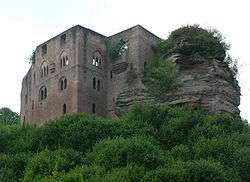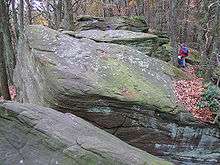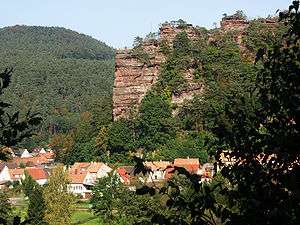Walking routes in the Palatine Forest
Walking routes in the Palatine Forest fall into two categories. The first are longer walking routes, most of which are maintained by the Palatine Forest Club (German: Pfälzerwald-Verein), or PWV, and which are linked to the national and international network of long distance paths.[1] The second category are those local circular walks and themed walking routes, some of which are of wider regional importance, and which are maintained by municipal authorities. The Palatine Forest, as part of the Palatine Forest-North Vosges Biosphere Reserve, is an important conservation area. As a result, the Palatine Forest, the bunter sandstone landscape of the Palatine Forest Nature Park, the castles in the Dahner Felsenland and the cross-border paths into Alsace and the Vosges make the region particularly popular with ramblers and walkers.[2]

Long distance paths
This section lists those long distance paths that run through the Palatine Forest.
International long distance paths
- along the Nahegau-Wasgau-Vosges long distance path (white cross) from Niederhausen an der Nahe via the Donnersberg and Hochspeyer to Johanniskreuz, and
- along the red cross trail from Johanniskreuz over the Eschkopf and Edenkoben to Speyer.[3]
National long distance paths
Saar-Rhine trails
These two trails run from Saarbrücken through the Palatine Forest to the River Rhine near Wörth.
Regional paths
This section lists the walking routes of the Palatine Forest region.
Walking network of the Palatine Forest
Paths through Johanniskreuz (waymark: coloured cross)
In addition to the long distance paths waymarked by a white cross, red cross and yellow cross, all other paths in the Palatine Forest that are marked with a cross pass through the hamlet of Johanniskreuz (the name means "St John's Cross"):
West Palatinate Way (waymark: coloured W)
On the West Palatinate Way, waymarked with a coloured letter W, the Association for the Promotion of Tourism in the West Palatinate (Verein zur Förderung des Tourismus in der Westpfalz) used to offer guided tours with luggage transfer. Both this service and its waymarking have not been maintained since 2009.[4]
Waymark: coloured bars

Waymark: coloured dots

Certified paths
The Palatinate Tourist Office worked in cooperation with the Association of German Mountain and Hiking Clubs (Deutscher Wanderverband) on the routes for three certified paths which were opened in April 2011, two of which run through the Palatine Forest:
- The Palatine Wine Path (Pfälzer Weinsteig, 153 km, ten one-day stages) runs from north to south from Neuleiningen along the Haardt mountains to Schweigen-Rechtenbach.
- The Palatine Forest Path (Pfälzer Waldpfad, 142 km, nine one-day stages) runs from Kaiserslautern through the Palatine Holzland and the Wasgau also to Schweigen-Rechtenbach.
Themed walks
- Baumwipfelpfad ("Treetop Path") – at the Fischbach Biosphere House. The path, for which a fee is payable, runs through the trees and treetops at heights of up to 35 metres for a distance of 270 metres. Nearby there is a Water Experience Way (Wasser-Erlebnis-Weg).
- Waterway trail on the Moosalbe (Gewässerwanderweg an der Moosalbe) – this is one of seven walks on the subject of water engineering in Rhineland-Palatinate. The way runs for over 33 km along the Moosalbe and Hirschalbe streams. Information provided by the Ministry for the Environment and Forests[5] at various waypoints covers the topics of:
- Mills, weirs and springs,
- Springs, water structures and ecosystems.
- Rätselhafte Zeitzeichen – historical themed walk by the municipal authorities of Enkenbach-Alsenborn and Hochspeyer, with the following sections:[6]
- Hochfelsweg ("High Rock Way") (12 km)
- Keltenweg ("Celtic Way" and Römerweg ("Roman Way") (9 km)
- Mönchsweg ("Monk's Way") I (12 km) und Mönchsweg II (14 km)
- Schanzenweg ("Fieldwork Way") (13 km)
- Sonnwendweg ("Solstice Way") (9 km)
- Skulpturenweg Rheinland-Pfalz ("Rhineland-Palatinate Sculpture Way") – this sculpture walk is planned in future to run through the whole of Rhineland-Palatinate. It currently comprises local sections.[7] These are found in the Palatine Forest at:
- Schweinstal, Krickenbach, Queidersbach
- Trippstadt, Stelzenberg
- Trippstadt, Johanniskreuz
- Spurensuche ("Tracking") – four forest history walks in the Johanniskreuz forest district:
- Footpath (Weg) 1 (yellow, 21 km, 21 stations) via Lauberhof, Karlstal and Meiserhof.
- Footpath 2 (red, 14.5 km, 21 stations) via Erlenbach and Eschkopf.
- Footpath 3 (blue, 19.5 km, 21 Stations) via Dämmchen, Mückenwiese and Speyerbrunn.
- Footpath 4 (green, 19 km, 22 Stations, not from Johanniskreuz, but Trippstadt) via Antonihof and Aschbacherhof.
- The Rodalber Felsenweg ("Rodalb Rock Way", circular path, 43.305 km, 5 stages are recommended that increase the total length, including approach and departure routes to 61.9 km) was laid out by the Palatinate Forest Club and the municipalities of Rodalben in the early 1990s. It snakes through various side valleys around Rodalben and passes 26 bizarre rock formations of bunter sandstone that are typical of the region. In 2007 it was elevated by the German Rambling Association to a certified trail.
- The Brunnenwanderweg ("Fountain Trail") near Heltersberg: the trail was opened in 2009 and is 40.3 km long, has 64 theme-related stations and in the area around the village of Heltersberg. The 30 or so voluntary renovated fountains form the highlight of the path; other features include near-natural, unique mixed woods and bizarre rock formations (crags and blockfields). The cultural historic background to the trail is documented on detailed information boards and a guide brochure.[8]
Local footpaths
Many villages and municipalities in the Palatine Forest have marked out local footpaths. These circular routes are usually waymarked with numbers and are of short to medium length, mainly used by local people. The care of these circular walks (waymarking, clearing) has been very neglected in recent years due to lower demand and tighter budgets. As a result, some can only be located with the aid of topographic maps.
Common waymarking systems
Since the foundation of the Palatine Forest Club and the Vosges Club (French: Club Vosgien) about 100 years ago, both rambling clubs have used almost identical waymarking systems. As a result, not only are cross-border walks made very easy but it also supports the fact that the Palatinate Forest and the Vosges form a single unit from both a geomorphological and a topographical perspective, and should therefore really only be viewed as two halves of an overarching mountain range on the left bank of the Rhine.[9][10]
Literature
- Klaus Frölich: Natur und Kultur an den Wanderwegen des PWV, Teil I : Kreuzmarkierungen. In: Pfälzerwaldverein (Hrsg): Wanderführer, Broschüren usw.. Selbstverlag Neustadt/W. 2006.
- Klaus Frölich: Burgenwanderweg – Teil II. In: Pfälzerwaldverein (Hrsg): Wanderführer, Broschüren usw.. Selbstverlag Neustadt/W. o. J.
- Pfälzerwaldverein (Hrsg): Zabernweg-Führer, Wanderweg zwischen Rheinzabern – Bad Bergzabern – Saverne (170 km). Selbstverlag Neustadt/W. o. J.
- Kurt Reh: Der Pfälzerwald - eine Einführung in Landschaft und Namengebung.In: Michael Geiger u. a. (Hrsg): Pfälzische Landeskunde, Beiträge zu Geographie, Biologie, Volkskunde und Geschichte. Bd. 1. Selbstverlag, Landau/Pf. 1981, S. 379-388.
- Susanne Rieß-Stumm: Pfälzer Jakobswege. 9. Auflage. Kuntz Verlag, Gleishorbach 2009, ISBN 978-3-933507-03-7.
- Barbara Christine Titz, Jörg-Thomas Titz: Pfälzerwald und Deutsche Weinstraße: 50 ausgewählte Tal- und Höhenwanderungen der Region Leiningerland, Haardt, Weinstraße und Pfälzerwald. 4. Auflage. Bergverlag Rother, Oberhaching 2009, ISBN 978-3-7633-4268-6.
External links
| Wikimedia Commons has media related to Walking routes in the Palatine Forest. |
References
- Übersicht Fernwanderwege und regionale Wanderwege Website by Hilmar Schmitt, linked also by the Website of the Palatine Forest Club. Retrieved 11 April 2011
- 1:25,000 and 1:50,000 topographic map series by the Rhineland-Palatinate Department of Survey and Geobasis Information at their official website. Retrieved 1 April 2011
- Naturpark Pfälzerwald, Wander- und Erlebniskarte 1:50,000, ISBN 3-927416-44-4.
- Die Rheinpfalz, Südwestdeutsche Zeitung: Hat sich das „W“ totgelaufen?, 3 April 2009
- Ministerium für Umwelt und Forsten Rheinland-Pfalz. "Gewässerwanderwege". Landesamt für Umwelt, Wasserwirtschaft und Gewerbeaufsicht Rheinland-Pfalz. Retrieved 16 June 2008.
- I. Christmann, S. Tie. "Rätselhafte Zeitzeichen". Verbandsgemeinden Enkenbach-Alsenborn und Hochspeyer. Retrieved 29 November 2009.
- Prof. Dr.-Ing. Dieter Wüstenberg. "Skulpturenweg". Skulpturenweg Rheinland-Pfalz e.V. Retrieved 15 June 2008.
- Begleitbroschüre des Brunnenwanderweges (pdf; 5.8 MB) Heltersberg website. Retrieved 12 April 2011
- Kurt Reh: Der Pfälzerwald - Eine Einführung in Landschaft und Namengebung. In: Michael Geiger et al. (ed): Pfälzische Landeskunde, Beiträge zu Geographie, Biologie, Volkskunde und Geschichte. Vol. 1. Selbstverlag, Landau/Pf. 1981, p. 381.
- Markierungssystem des Vogesenclubs (Fr: Club Vosgien). Website des Club Vosgien. Retrieved 11 April 2011

